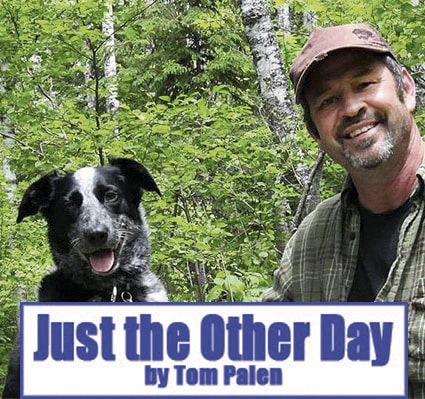Tom Palen,a broadcaster, pilot, writer, and our Guest Columnist! Archives
July 2024
Categories |
Back to Blog
Guardrails10/14/2020 Normally our fall trip would take us into Canada; sometimes trekking all the way up to Nova Scotia, sometimes just camping at Sleeping Giant Provincial Park. Other times driving to Agawa Bay, or making the full circle around Lake Superior, however 2020 has been everything but a normal a year. The Canadian border was closed, so we would travel a different direction. We opted to head west to Ouray, Colorado, then south for Texas, before returning home.
Colorado has challenges unique to the mountains. Driving from Ouray, to Silverton, takes you along a route known as the Million Dollar Highway. This road offers some of the most spectacular sights in the San Juan Mountains along some of the most dangerous roads. Dangerous in that the narrow road winds and turns following the mountain side. Speeds are often reduced to 10 or 15 MPH to maneuver the multiple switchbacks in the road. Driving this route can raise the hair on your arms and the back of your neck as most of this road has no guardrails. There are places where the white line marking the edge of the driving lane is literally on the edge of a cliff that falls hundreds – if not thousands – of feet to the valley below. The cliff is so close to the road and so steep, there isn’t room to put up guardrails. With all her beauty, the road is unforgiving and the consequences severe. If you’re one of those drivers who is constantly hearing the rumble strips on the side of the pavement, you should not drive this highway. There is no room for error. Colorado offers beautiful fall colors and spectacular sights that can easily humble a man. Thousands of acres of brilliant gold aspen leaves and dark green pine trees against the mountain sides and down into the valleys, are a sight to behold – one you’ll never forget. Looking up at rocky cathedrals that reach into the purest of blue skies is humbling. It makes me realize how small I am in the midst of all of this majesty. Water babbling over rocks in the creeks and rivers, along with the sound of the wind, creates a symphony of nature’s best music. It’s absolutely breathtaking – or could it be the altitude? Our home in Minnesota is at an elevation of 750 feet above sea level. Silverton, Colorado, where we would be camping, sits at 10,505 feet. That difference can make breathing difficult as the air is very thin. Albeit the most important, breathing is just one of the many challenges that come with high altitude. Thin, dry air changes all the rules for baking, too; something I love to do. One of our destinations in the mountains would be Lake City. We rented a cabin from our new friends (whom we had yet to meet) John and Lynne. Lynne said she had heard many stories about us from her dear friends, Kenny and Gail - Melissa’s aunt and uncle from Texas. Lynne invited us to dinner one night, saying she felt like she already knew us and couldn’t wait to meet in person. I was flattered to learn they had heard about my pies. I said I would bake a pie for them if I could use their kitchen. Lynne told Melissa she had also heard Gail raving about my dinner rolls but she didn’t want me to be stuck in the kitchen too long. I laughed because I love being in the kitchen, “Tell Lynne she will get the pie and the rolls and she can still order up to two entrees.” It wasn’t long after I extended my offer that Melissa and I were hiking up the side of a mountain. The path followed the edge of a stream with several little waterfalls. The thin air had me huffing and puffing my way along the trail. We wanted to, or should I say needed to, be off the mountain before the sun went down behind the other mountains across the valley, leaving us in a cold shadow. Still, we wanted to make it to the top of the trail on the Continental Divide, where there was a really cool waterfall. We were both getting tired, although our dog June seemed to be doing just fine with energy to spare. Each time I wanted to quit and turn around, Melissa would say, “Let’s just go a little further – ten more minutes.” When we had climbed ten more minutes, she would be ready to call it enough and start back down the mountain. “Let’s go just a little farther.” I would tell her, “I’m pretty sure I can hear the waterfall now.” I’m not really sure if I was hearing the falls or if the sound was like a mirage of an oasis in the desert. Although tired, we eventually encouraged one another to the top of the hill. Taking deep intentional breaths, we rested on a log alongside the waterfall. I started wondering just how high we were. “We must have climbed about 2,000 feet.” I figured. That’s when it occurred to me that Lynn’s house is at an elevation of 9,200 feet. I’ve read that anything over 3,000 feet really changes the way baking works – especially when working with yeast and breads. There were high expectations for my pie and rolls. I’d never baked at high altitude. What if they didn’t turn out? Would I be shunned from baking in the San Juan Mountains for the rest of time? It was like driving one of those roads without guardrails; there was nothing there to keep me from falling. I started to feel a little panicky. “Maybe it’s just the thin air.” I justified as we started down the big hill. Back at our cabin, I immediately got online to research high altitude baking. The article read: Pies aren’t as affected as yeast breads, although there can be differences… “Yeah, yeah. Blah, blah. Blah.” I rebuked the article. “I have my pies down pat. I don’t need any advice on pies – let’s get to the differences in bread making.” I made notes: Cut the yeast by one third. Use cold water and add a quarter cup. Knead the dough with oiled hands, not floured. Watch the rising time and remember the rolls will bake quicker. “Got it!” I declared with confidence. When we got to Lynn’s house, she showed me around the kitchen. It’s wasn’t long before I had a peach pie in the oven. I started my dinner rolls. I kept a close eye on the pie baking, as well as the dough while it was rising. Hmm. The pie seemed to take a little longer to bake before the filling boiled. “It must be the high altitude.” I concluded. Soon, I took the pie from the hot oven. Everyone oohed and aahed at its wonderful appearance and sweet aroma. I was quite proud of the pie, however, I was concerned that it wouldn’t have enough time to fully set up before dessert was to be served. We set the pie outdoors for faster cooling. I put the rolls in the oven as everyone was sitting down to eat. Again, I kept a close watch on them. When the rolls came out of the oven, I brushed the tops with melted butter and served them. The moment of truth was at hand; I watched for facial expressions as each person bit into their rolls. Everyone complimented how good they were. I tried to remain humble when everyone took a second roll, but inside I was dancing and cheering myself, “Yes! Yes! I did it. Who needs guardrails? Even at high altitude, I nailed the rolls perfectly!” I couldn’t wait to serve the pie. With a stack of clean dessert plates, I took a knife and cut into my beautiful, perfect pie on the kitchen island. What? Why wasn’t the knife gliding through the crust? In the bottom of the pie pan it felt like I was cutting through a rock and my usual light, flaky top crust was hard and crisp like a cracker. When I lifted the first slice, the bottom crust stayed in the pan and the filling was runny. Suddenly, I felt like I was careening over the white line on the edge of the road and plummeting into the harsh valley below. There was no guardrail to save me. I’ve always said, “Crust is easy and it will make or break your pie.” If you have a mediocre filling but a good crust, people will say, “The crust was great.” On the other hand, if you have a really good filling but a bad crust, people will note, “The crust was kind of tough.” I took a bite of the pie. The filling was really good, but all I could think is “This crust is lousy.” “What happened?” I wondered as I retraced every step of making the pie. I did everything the way I always do. Then I remembered before I made the pie, boasting to myself, “I don’t need any advice on pies…” I guess it is true, the mountains do have a way of humbling a man – in many ways. The heavy dose of humility was well deserved and brought me down a few steps in ways that I needed to be. I took another bite of the lousy pie I had baked, then thanked God that I was in the kitchen and not on the mountain pass as I went arrogantly speeding down a road with no guardrails.
0 Comments
Read More
Leave a Reply. |

Contact Us:
Phone: 507.238.9456
e-mail: [email protected]
Photo Press | 112 E. First Street |
P.O. Box 973 | Fairmont, MN 56031
Office Hours:
Monday-Friday 8:00 a.m. - 4:00 p.m.
Phone: 507.238.9456
e-mail: [email protected]
Photo Press | 112 E. First Street |
P.O. Box 973 | Fairmont, MN 56031
Office Hours:
Monday-Friday 8:00 a.m. - 4:00 p.m.
Proudly powered by Weebly



 RSS Feed
RSS Feed